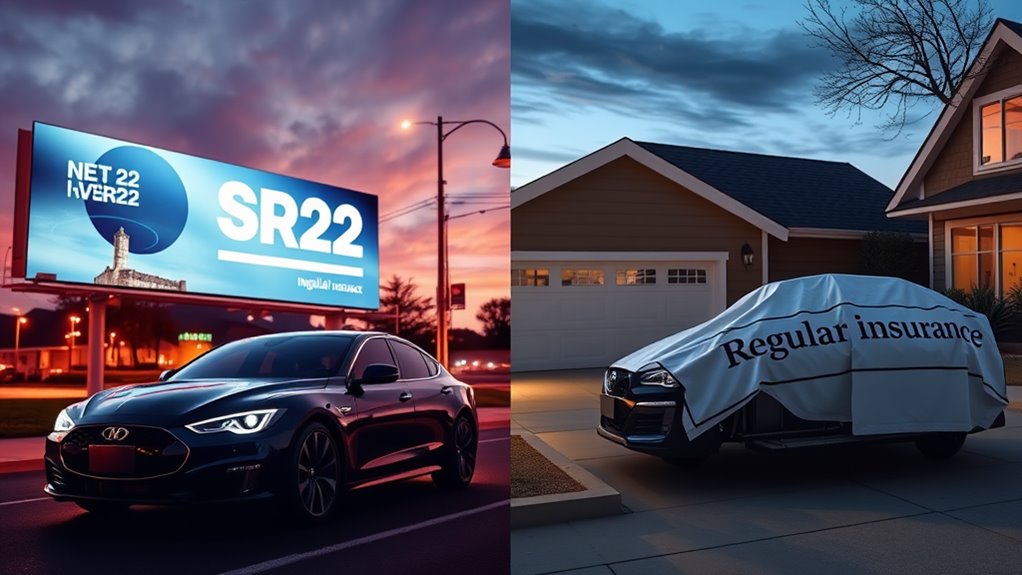How to Compare SR22 and Regular Insurance
When it comes to comparing SR-22 and regular insurance, you need to weigh several essential factors. SR-22 is often more expensive due to the high-risk designation linked to serious infractions. You'll want to look closely at the minimum liability coverage required for SR-22 versus the customizable options of regular insurance. State-specific requirements can also play a significant role in determining your best choice. Understanding these nuances can reveal surprising insights about your insurance needs.
When you're trying to decide between SR-22 and regular insurance, understanding their differences is vital, especially if you've had driving infractions that put you in a high-risk category. An SR-22 isn't a type of insurance; rather, it's a certificate your insurance company files with the state to confirm that you meet the minimum coverage requirements. This filing is often necessary for high-risk drivers, usually due to serious incidents like DUIs or other severe infractions. Additionally, affordable SR-22 insurance options can help you find suitable coverage despite the high-risk classification.
Understanding the differences between SR-22 and regular insurance is crucial for high-risk drivers facing infractions.
In contrast, regular insurance provides broader financial protection against accidents and various vehicle-related incidents without the need for state verification.
Cost-wise, SR-22 insurance typically comes with a higher price tag than regular insurance. This increased cost is due to the high-risk classification associated with a driving history that necessitates SR-22. Regular insurance premiums are generally lower as they fall into standard or preferred risk categories.
While there's usually a one-time SR-22 filing fee around $25, keep in mind that additional surcharges may apply based on your specific driving incidents. If you're looking to save on costs, opting for basic liability coverage under an SR-22 can be a smart choice, as extensive or collision coverage mightn't be necessary.
When it comes to coverage options, both SR-22 and regular insurance can provide similar levels of coverage, including liability, extensive, and collision. However, SR-22 insurance often emphasizes minimum liability coverage to fulfill state requirements. Liability coverage is required by the state for SR-22 issuance, which can help drivers meet their legal obligations.
Regular insurance, on the other hand, doesn't require state notification and can offer more flexibility regarding the coverage you select. You can also add extras like roadside assistance to both types of policies, but remember that extensive and collision coverage are usually not mandated by states, although they may be required for financed vehicles.
Risk classification plays a significant role in determining your insurance premiums. SR-22 policies are labeled as high-risk due to serious driving infractions, which naturally leads to increased costs.
Regular insurance can offer various classifications, from standard to high-risk, based on your driving history. It's significant to recognize that the risk factors linked to SR-22 can impact your rates for up to three years, reinforcing the need for careful consideration of your driving habits.
State requirements further differentiate SR-22 from regular insurance. States mandate SR-22 certificates to guarantee compliance with minimum insurance requirements, while regular insurance meets these mandates without the need for state verification.
Each state has unique minimum coverage requirements, and some, like New Hampshire and Virginia, have specific exceptions that may affect your decision. Generally, SR-22 is required for drivers with suspended or revoked licenses, making it necessary to remain compliant.
Finally, managing an SR-22 policy involves additional responsibilities. Insurance companies must notify the state if your coverage lapses, while regular insurance usually doesn't require such notifications unless your coverage directly affects your license status.
Keeping your SR-22 active for the required period is vital, as lapses can lead to suspended driving privileges. Always confirm timely policy renewals to avoid complications in your coverage status. By understanding these key differences, you can make an informed decision that best suits your needs.
Conclusion
When it comes down to SR-22 versus regular insurance, the differences are as stark as night and day. You'll face higher premiums with SR-22, reflecting your high-risk status, while regular insurance offers a buffet of coverage options to fit your needs. Don't forget to dive deep into state requirements, as they can change everything! Ultimately, knowing your options can save you not just money, but potentially your driving privileges. Choose wisely and drive confidently!
